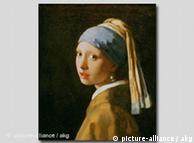Pulse | 22.06.2010 | 16:30
Psychology art tours
The students are all studying at the Business School of Potsdam. Their tours run on Thursday evenings, when entrance to the museum is free.
Report: Leah McDonnell
 Portrait of a young girl by Petrus Christus |
 One of the rooms with German medieval sacred art |
The Gemäldegalerie is an art museum in Berlin, Germany. It holds one of the world's leading collections of European art from the 13th to the 18th centuries. It is located on Kulturforum west of Potsdamer Platz. Its collection includes masterpieces from such artists as Albrecht Dürer, Lucas Cranach, Raphael, Titian, Caravaggio, Peter Paul Rubens, Rembrandt and Johannes Vermeer. It was first opened in 1830, and was rebuilt in 1998.
| Contents [hide] |
History

The collection was first located in the Royal Museum located near Lustgarten on Unter den Linden, a famous Berlin street. The collection began largely with the collection of Frederick William I, known as the Great Elector and Frederick the Great.[1] It was along the centuries enlarged not only through acquisitions but also by means of war booty and contains many objects looted from Poland. These were paintings obtained from the royal collections in 1656 (Polish Vasas collection),[2] in 1740 (Silesian collection of John III Sobieski) and in the beginning of the 19th century (Stanisław Augustus collection), as well as from many confiscations after the Partitions of Poland.[3]
The gallery's first director was Gustav Friedrich Waagen. Berlin's premier name in museum direction, Wilhelm von Bode, served the gallery from 1890 to 1929. His leadership marked the rise of the Gemäldegalerie to international prominence.
In 1904 the Gemäldegalerie was largely a collection of Renaissance art when it moved to the newly built Kaiser Friedrich Museum, later known as the Bode Museum. The museum was badly damaged during World War II, however most of the collection survived the war in shelters across Germany. At the end of world war II however, 400 art pieces were destroyed in a fire of a Flak tower that served as bomb shelter. Furthermore, several hundred paintings looted by Russian as well as American soldiers or confiscated and never returned by the red army. The rest of the collection was divided between East Berlin (mostly at the Bode Museum on Museumsinsel) and West Berlin in Berlin-Dahlem.
In June 2006 a painting missing since 1944 by Alessandro Allori was returned by the British journalist Charles Wheeler.[4]
The collection
The Gemäldegalerie prides itself on its scientific methodology in collecting and displaying art. Each room can be taken in as a single statement about one to five artists in a certain period or following a certain style. Especially notable rooms include the octagonal Rembrandt room and a room containing five different Madonnas by Raphael.

Other notable experiences include Flemish moralistic paintings which stretch across the north side of the museum, showing an interplay between the religious motives of the artists' patrons and the often sensual inspirations of the artists. In the Renaissance section, for example, Caravaggio's Amor Victorious is displayed alongside Giovanni Baglione's Sacred Love Versus Profane Love. The two paintings are historically connected; after hearing of the scandalous portrayal of the theme "love conquers all" in Carvaggio's work, a Roman bishop commissioned Baglionne's reply, which mimics Carvaggio's style, including the features of Amor.
The tour
The collection is arranged more or less chronologically starting from the entrance and moving toward the farthest wall. Following the rooms as they are numbered takes the visitor first forward, then backward, in time. The numbering system starting on the north side of the museum yields mostly Northern European art, then British portrait art. A visitor following along the southern side will go through mostly Italian and Southern European art. The gallery contains 1200 works, with around 400 more downstairs.
Architecture and layout
The gallery sits in the southwest corner of the Kulturforum, a modern-styled answer to East Berlin's Museumsinsel (Museum Island) which was inaccessible to West Berliners when the city was divided by the Berlin Wall from 1961 through 1989. The gallery was designed by Munich architects Heinz Hilmer and Christoph Sattler. The building consists of 72 rooms providing a two-kilometer (1.25 mi) floor. Upstairs the rooms flow around a center hall the size of a football (soccer) field; the hall sometimes displays sculpture. There are also works downstairs, a gallery devoted to frames, and a digital gallery.
Notes
- ^ The core of the collection was formed from the art treasures belonging to The Great Elector (1620-1688) and Frederick the Great (1712-1786).
(English) "Old Master Paintings". www.smb.spk-berlin.de. http://www.smb.spk-berlin.de/smb/sammlungen/details.php?lang=en&objID=5&p=1. Retrieved 2009-11-26. - ^ Relation by Wawrzyniec Rudawski. (Polish) Lileyko Jerzy (1980). Vademecum Zamku Warszawskiego. Warsaw. p. 45. ISBN 83-22318-18-9.
- ^ Stosunek władców Prus do kultury polskiej ilustruje wywóz ze Śląska, jeszcze w 1740 r., zbiorów Jana III Sobieskiego, (...) rekwizycje dzieł sztuki z "pruskiej" Warszawy, z początkiem wieku XIX, wywóz części zbiorów Stanisława Augusta Poniatowskiego.
(Polish) Jan Pruszyński. "Kulturkampf". www.wprost.pl. http://www.wprost.pl/ar/70605/Kulturkampf/. Retrieved 2009-11-26. - ^ Harding, Luke. "Renaissance woman returned to gallery". The Guardian, 01 June 2006. Retrieved on 12 October 2007.
External links
| Wikimedia Commons has media related to: Gemäldegalerie |
- Staatliche Museen zu Berlin | Gemäldegalerie
- Kaiser-Friedrich-Museums-Verein Association of the friends of the Gemäldegalerie
- www.kulturforum-berlin.com Information about all cultural institutions at the "Kulturforum" in Berlin
- Review of Gemäldegalerie


沒有留言:
張貼留言